When I was five my father bought a boat. She wasn't his first boat, he'd had others before he married my mother, but she was the first boat I remember. She was an eight foot long catamaran, called Catkin, with a gunter sloop rig. I can remember being very excited when she arrived, and when we first went sailing at Carrick Shore near Gatehouse. At first my father went out by himself, but very soon I and one or other of my sisters would be tucked up in the front of the cockpit, with our legs under the foredeck.
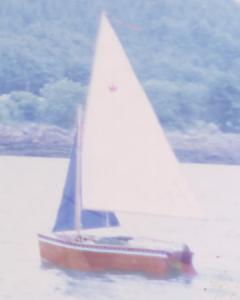 Catkin off Gull Craig, Kircudbright bay. according to the
notes on the back of the print I'm sailing, but if so I seem
to have been beheaded... I would be nine or ten in this
picture.
Catkin off Gull Craig, Kircudbright bay. according to the
notes on the back of the print I'm sailing, but if so I seem
to have been beheaded... I would be nine or ten in this
picture.
By the time I was seven I was sailing her myself on inland water, mostly Linlithgow Loch, as my father had graduated to a series of larger boats, and by the time I was ten I was sailing her on Kircudbright and Auchencairn bays.
She's also the only boat I've ever capsized by accident - I was caught in a squall on the start line of a race, and was sitting on the mainsheet. Ooops! I was ten at the time, and couldn't right her. She remained in the family, and I still sailed her occasionally, into my twenties.
I got a boat of my own for my twelth birthday. She was an old - at least forty years old - clinker built schallop with a standing lug rig. She had fallen off a trailer and was stove in down one side, and her sail was rotten. But she was a boat and she was mine. Over the winter (with some adult assistance, but mainly by myself) I replaced the sheer strake and gunwhale on the port side and doubled a number of broken ribs, and she was back in the water very early in spring.
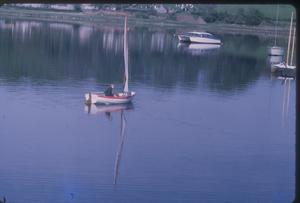 Osprey in Kirkcudbright Harbour, probably about March 1968. She
still has her original cotton sail, which I replaced later that
spring. Noa Noa (see below) is visible at the extreme right of
the picture.
Osprey in Kirkcudbright Harbour, probably about March 1968. She
still has her original cotton sail, which I replaced later that
spring. Noa Noa (see below) is visible at the extreme right of
the picture.
Osprey remained my only boat for ten years, and I had a lot of fun in her in that time, mainly in Kirkcudbright bay. She wasn't fast by comparison to modern dinghies, but she sailed well and rowed well. I eventually gave her away, and last saw he lying on the shore at Rascarrel Bay in a very sorry state.
The same winter I was given Osprey, my father had a 22 foot Wharram Hina built for him by Jim Hunter. She was initially ketch rigged with spritsails. Later she went through a series of rig changes; first her mizzen was enlarged, then a bowsprit was added, then the sprits (which were always a nuisance) were replaced by gaffs, then the mizzen was removed, and finally she was converted to a bermudan sloop.
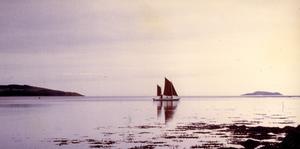 Noa in Kirkcudbright Bay shortly after launch, with her original rig.
Noa in Kirkcudbright Bay shortly after launch, with her original rig.
Why all the change? The original spritsail ketch rig was not efficient, especially to windward. Replacing the sprits with gaffs made the sails easier to handle, but hte sails still suffered from twist. The final Bermudan sloop rig was hugely more efficient, and converted a comfortable and seaworthy day cruising boat into a very rapid machine. However it has to be said that I often felt that my fether preferred modifying boats to actually sailing them.
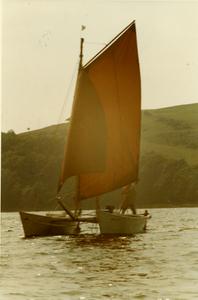 My father sailing Noa single handed, picture taken from Osprey..
My father sailing Noa single handed, picture taken from Osprey..
We sailed Noa all through my adolescence between Auchencairn Bay and the Isle of Whithorn, occasionally camping overnight but never doing any night passages. It's interesting to compare Noa with Dances - a later design by the same designer, only four feet longer, but feeling in many ways a great deal bigger.
All through my childhood the most beautiful boat on Kirkcudbright river was a pre-war 2.5 ton centerboarder called Stillyet, a classic boat with extraordinarily graceful lines. I admired her for years. Sometime in my late teens she was sold and disappeared from Kirkcudbright. In 1978 I saw her sitting on the saltmarsh at Kippford, looking neglected and derelict. After a bit of asking around I bought her for a song.
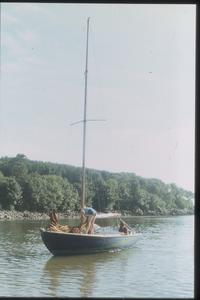 Stillyet at the Doon, Kirkcudbright bay, sometime in 78 or 79;
we were dropping friends off there on the way back from Ardwall
to Balcary. In this picture she still has her original cabin top.
Stillyet at the Doon, Kirkcudbright bay, sometime in 78 or 79;
we were dropping friends off there on the way back from Ardwall
to Balcary. In this picture she still has her original cabin top.
Stillyet was the most beautiful boat I've ever had, and in many ways the best; certainly she's the one of which I have the best memories. She had her faults, as all boats do; she could wallow horribly in a slop, and her centreboard tended to jam. With her huge mast and big open cockpit, running in strong winds was always interesting - a jibe would be very likely to bring the mast down, and a broach or knockdown would probably have sunk her. When she took the ground (and in the Solway there are very few all-tide anchorages) she lay over so far that you certainly fell out of your bunk, and if you weren't lucky the bilgewater got into the matress.
But her virtues outweighed them. She was beautiful, and she sailed beautifully. She would self steer for long periods just on sail trim. She would go to windward with her centreboard up, and with two foot four inches draft could get into places where traditional yachts are not expected. She was sea-kindly, with (under most conditions) a very easy motion, and would heave to quietly in atrocious conditions (I remember one night passage to the Isle of Man where things got so horrible around the tail of the Bahama Bank that I just hove to and went to bed - waking up after a pleasant night's sleep about five miles off Sellafield).
I sailed her all over the northern Irish Sea, and lived aboard for six months in Glasson Dock, Lancaster. Obviously, it was cramped. There was less than four feet from the cabin sole to the highest point of the coachroof, and you couldn't sit upright in your bunk. But I found it far more congenial than student residences, which were the alternative. Interestingly, Pete and Annie Hill were building Badger at Glasson Dock at that time, and I often saw them, but was much too shy to speak to them.
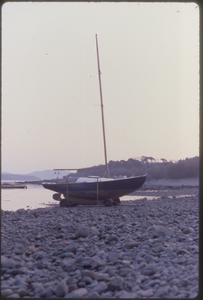 Stillyet on her trailer at Balcary, waiting to refloat, April
1982. The cabin top (which had always leaked around the
coamings) has been replaced by an arched deck.
Stillyet on her trailer at Balcary, waiting to refloat, April
1982. The cabin top (which had always leaked around the
coamings) has been replaced by an arched deck.
Stillyet was an old boat, and needed a fair bit of maintenance. On her last long trip, from Glasson back to Balcary in June 1983, she started a seam forward and leaked badly. On investigation I found that many of her fastenings had corroded into little scraps of pinky coloured wire, and I realised she needed to be completely refastened. I was then a student on a grant, and (as students commonly are) very broke. I layed her up hoping to be able to earn enough to repair her after I had graduated. However a year later someone came and asked me if they could buy her mast and anchors for a boat they were fitting out. I'd seen enough hulks lying on the saltmarsh gradually decaying as owners could not afford to repair them, and didn't want Stillyet to become one of those. I was still broke and could not see any real prospect of not being, and I made a decision I've regretted ever since. I decided to break her up.
Two years later I had a good job and could easily have afforded to pay someone to refasten her...
In the years after I'd scrapped Stillyet I hired boats - mostly Squibs on Lake Windermere - and scrounged sails on other people's boats. In about 1986 I was poking around a boatyard on Coniston Water when I came upon a Hunter 19 for sale. In many ways she was the wrong boat, with her deep fin keel; but she was cheap and (having the same hull as the Squibs) I knew she would sail. Because I was still working in Lancaster, and because she was the wrong boat for the Irish Sea, I put her on Ullswater and sailed her there for some three years.
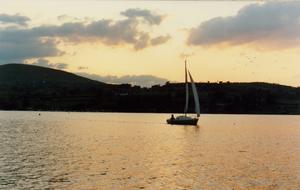 Gem on Ullswater; this photograph taken from the steamer peir
at Pooley Bridge..
Gem on Ullswater; this photograph taken from the steamer peir
at Pooley Bridge..
Gem could sail, and did sail very well. And Ullswater, although it is a little pond, is a very pretty little pond with some very nice anchorages. Sailing without having to worry about tides was also very pleasant. But in the end sailing on a pond was too restricting, and I looked for a boat seaworthy enough to handle open water, small enough to trail behind the car, and able to take the mud.
Selchie was a standard glassfibre Drascombe Lugger, bought second hand but in reasonable condition. I kept her for ten years, which is the longest I've had any boat except Osprey, so she clearly did a lot of things right. I sailed her on Ullswater, on Coniston, on Woodhall Loch, and (primarily) on the Solway, cruising between Kippford and Ardwall. Her virtues were that she sailed reasonably well, even in very bumpy going; she hove to nicely; she was easy to maintain. She was even a lot of fun to sail one up, performing very nicely in any reasonable wind and quite manageable under sail even in gale conditions.
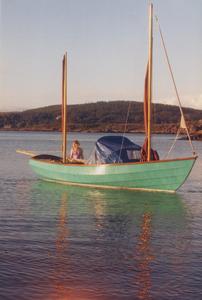 Selchie in White Horse Bay.
Selchie in White Horse Bay.
So what were her vices? Well, not very many, but somehow I never really loved her. You had to be extremely careful that he centreboard was secured in the up position before you left her on the mooring - if it got loose and fell down, she would sit down on it and damage herself badly (this happened twice). The 'drop through the slot' rudder was always a complete nuisance, although I never bent it (as other Drascombe owners have). She would not self steer at all. She was seaworthy enough to make open water passages, but in fact I never took her even as far as the Isle of Man - I think the issue really comes down to not having anywhere to brew up when you're sailing. Six hours at the tiller with no chance of a brew just isn't fun.
There are more pictures of Selchie here.
In 2001 I decided to get a new boat which could sail faster and go further. I intended to self build, and considered two boats: Iain Oughtread's Grey Seal, a very pretty little boat reminiscent of Stillyet, and a James Wharram's Tiki 30, a grown up and modernised sister of Noa. Why these two? Well, the criteria for a Solway cruiser are (in my opinion):
In addition, for me she also
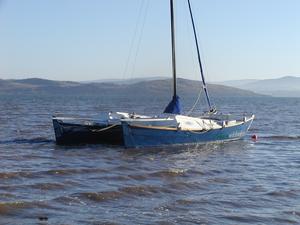 Dances on her mooring at Balcary, shortly after relaunching.
Dances on her mooring at Balcary, shortly after relaunching.
I knew Wharrams boats broadly met the criteria, but I also knew that small ones have poky, coffin like hulls which didn't meet my idea of comfort. I was initially more taken with the idea of the Grey Seal, but having considered the design I was intimidated by the idea of bending the strakes around the tight curves of the quarters - frankly, I didn't think I had the skill. And then I came across a Tiki 26 sitting in the corner of a back yard.
She had an interesting and, it seemed to me, rather sad history. The person who'd built her (with some care and skill) had sold her only three months after she'd been launched. Her second owner had had her in the water for only a few months more, and then parked her in his yard for three years. She had a grand total of 85 miles on her log.
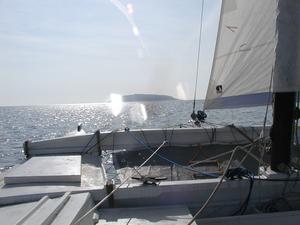 Dances in Auchencairn Bay, during shakedown.
Dances in Auchencairn Bay, during shakedown.
So what was wrong with her? After a careful look I decided that the answer was 'not very much', and bought her. It was clear she hadn't been a lucky boat, so I renamed her Dances with Waves.
I've put a lot of work into overhauling Dances, but have had her in the water only a few weeks at the time of writing. So far, she's living up to expectations. She's fast and seakindly, sails well, has a sheltered helming position, and a workable galley.
give me feedback on this page // show other people's feedback on this page